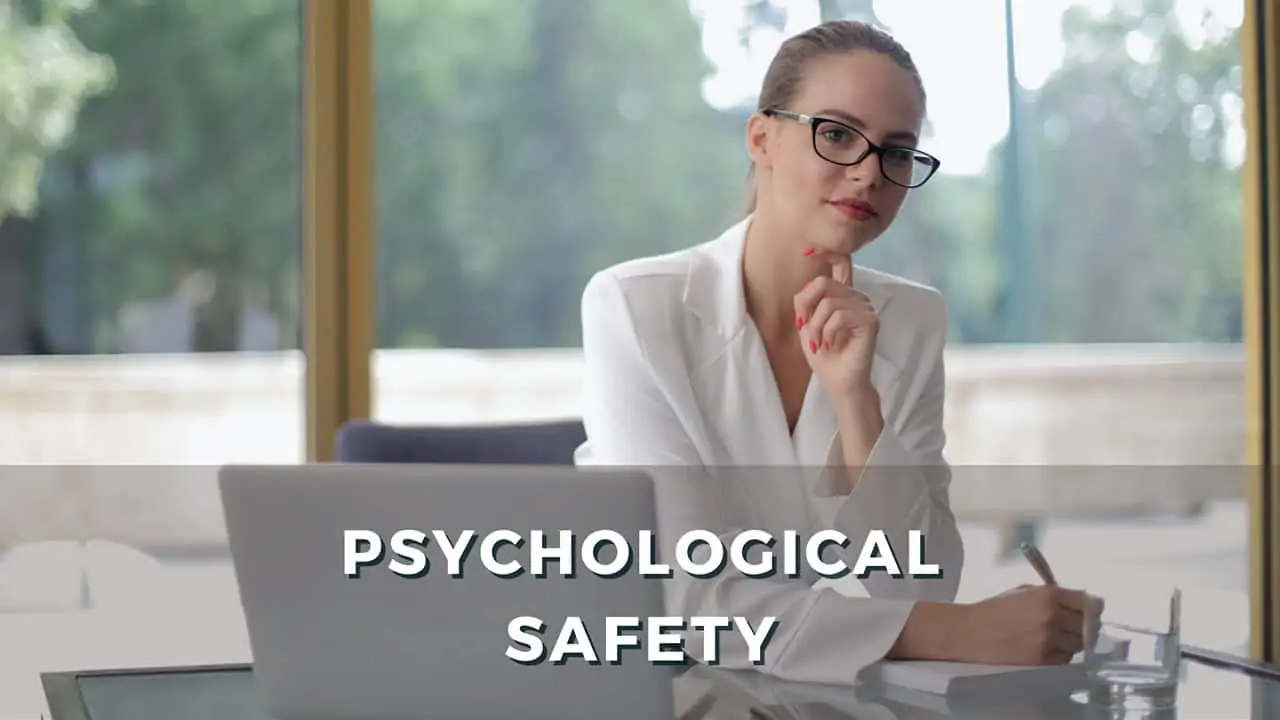Reading time: 10 minutes
Every company, and every relationship, needs psychological safety for its people to thrive.In an environment of psychological safety, people are able to take risks without causing physical or psychological harm to themselves, others, or their job. It is the feeling of “safety” in conceiving one’s ideas and employing their plans without fearing negative consequences on their self-image, position, or career.
A sense of psychological safety in a group ensures that everyone on the team feels secure enough to take interpersonal risks. In such environments, people feel accepted and valued, not threatened and silenced.
Definition of Psychological Safety
Psychological safety is the shared belief held by members of a team that the team is a safe space for interpersonal risk-taking. It refers to the feeling of security among the members in a co-working group in speaking up openly, making and acting on risky decisions, experimenting with new strategies, and accepting failures gracefully when things go wrong.
A team operating in a climate of high psychological safety has the following characteristics:
- Members of the team respect each other’s abilities.
- Members are interested in one another as people.
- They believe their teammates have positive intentions.
- They are not rejected for being themselves or stating what they think.

History of Psychological Safety
The notion of “psychological safety” was introduced by organizational researchers Schein and Bennis in the 1960s, to address the need for trust and mutual respect in the workplace.
William Kahn in the 1990s reignited the idea. Kahn showed that psychological safety enables people to “employ or express themselves physically, cognitively, and emotionally”.
Earlier, in 1982, the American statistician and engineer William Deming argued that creating an environment where team members feel safe to take risks is crucial to fostering creativity, innovation, and problem-solving. He wrote:
“Drive out fear, so that everyone may work effectively for the company.”
When employees feel like their ideas are listened to and valued, they are more likely to speak up when something needs improvement.
Psychological safety grew on the idea that humans feel motivated by two fundamental needs: to feel competent, and to feel connected.
With these two needs fulfilled, people are more likely to try new things and remain open to feedback. This sense of security encourages people to speak up when they have an idea or a concern.
Psychological safety is closely linked to the two other concepts — “team resilience” and “learning agility”. Many feel the concept of psychological safety emerged from research on “team resilience”. We may explain the relationship between these two concepts as:
Team resilience may be seen as a collection of shared attitudes, beliefs, and social norms learned through shared experiences that allow team members to be receptive to each other’s contributions while engaging constructively with their own vulnerabilities.
Though the idea of psychological safety has been around for a long time, in recent years, the term has been at the forefront of discussions about workplace culture and management.
In the last five years, the term’s global search volume has increased by more than 600%.
Why Is Psychological Safety Important?
A team’s level of psychological safety is important because higher levels of it can positively affect the individuals within that team. Psychological safety allows people to take risks, challenge assumptions, make mistakes, and learn.
A psychologically safe workplace provides employees with a sense of worth and belonging, as well as a feeling that they are being listened to. It also allows employees to be their authentic selves during the workday without fear of judgment or ridicule.
Deng, H., et al. (2019) found (Slacking Off in Comfort: A Dual-Pathway Model for Psychological Safety Climate) that psychological safety linked positively to group learning behavior and voice through reduced group average fear of failure.
Higher levels of psychological safety allow individuals within teams to use lateral thinking in their ideating process and communicate freely with each other. This is possible because they are not afraid to make mistakes or appear idiotic to say what’s really on their minds.
It also makes people feel more secure about making speedier, if riskier, decisions.
The process of feeling psychologically safe can be difficult for some, as they might have experienced traumatic events in their lives. However, you can make your company more psychologically safe by implementing processes such as inclusion, diversity, fearlessness to speak up, and promoting a feeling that mistakes will be forgiven if acknowledged.

Benefits of Psychological Safety At Workplace
Psychological safety is one of the most important elements to consider in your teamwork environment. It is vital for building trust, empathy, and respect among all members.
The benefits of psychological safety are increased morale, decreased employee turnover, increased job satisfaction, increased creativity, and better teamwork.
A safe work environment fosters a sense of trust and caring, allowing workers to feel comfortable taking risks. When people feel secure, they are more willing to communicate openly with one another. This results in improved employee creativity, fresh ideas, and faster resolution of challenges and issues.
When a team is more psychologically safe, they are more likely to collaborate and help one another. They are also less likely to have conflict and more likely to be happy with work.
For these reasons, it is imperative that managers and companies take steps to increase psychological safety in their workplace.
How To Increase Psychological Safety To Have Happier Employees?
Companies are now understanding the importance of psychological safety in the workplace. A work environment that is psychologically safe can be achieved and increased by establishing norms that value vulnerability, curiosity, and feedback in a given work setting.
There are various ways to accomplish this, like improving communication skills through practicing active listening, providing constructive feedback to employees on a regular basis, and helping employees understand that they can feel vulnerable without feeling unsafe.
The following can help increase psychological safety in the workplace:
- Sense of Control — Control over one’s work environment, along with control over what tasks are completed during office hours.
- Meaningful Work — Work that is personally meaningful, whether it be through the work itself or through the consequences of that work.
- Understanding — Being able to understand the perspectives of others in order to be better understanding oneself’s own feelings.
- Shared Vision — Share the company vision and values, including a fair knowledge of how the company fosters psychological safety.
- Recognition — Offer rewards for people who exemplify and help further the values of independent thinking, risk-taking, sharing of responsibilities.
- Open Communication — Create an open dialogue about any issues that might arise, and foster a culture of trust with employees by showing concern for their well-being and autonomy.
- Empathy Training — Showing employees how to develop empathy towards others and replace criticism with helpful feedback.

How To Ensure Psychological Safety While Recruiting?
Psychological safety is about “believing that the team will care for, protect, and value me.” You want to create that environment of psychological safety for all your employees, not just your top performers or your favorite people.
This culture sets in motion at the time of recruiting talent.
The prospective recruit must be communicated on how the company encourages novel thinking, open communication, and giving of honest feedback. During the orientation process, they could be shown how the culture of safety runs within the organization.
Psychological safety starts with the team leader being mindful of how they react to situations and others. The new recruit observes them using these moments to promote a culture of safety and naturally adopts them.
Leaders must also recognize that each person has different needs for safety, which is why it’s important to have a diverse group or team that can help support each other.
The good thing is that once you make people feel like they are welcome, like they belong, like they are part of the team, in a safe environment — it becomes hard to go back.
How Does Psychological Safety Impact Team-effectiveness?
According to a two-year study by Google, the highest-performing teams have a high degree of psychological safety.
The effect of high levels of psychological safety on individual members is that it allows them to be more open to new ideas, which in turn improves their creativity. This aspect directly affects the team because it means that they are able to respond more quickly and intelligently to changes in the environment, which helps them complete tasks more efficiently.
Teams with a higher level of psychological safety have better group cohesion, collaboration, and problem-solving. They work in an environment where members often achieve more because they feel confident taking risks.
[• You’d love to check this out: How To Stimulate Your Vagus Nerve And Calm Down]
Is There A Downside To Psychological Safety?
Psychological safety is not an all-pervasive solution to organizational performance over time. It may reduce a group’s average work motivation.
After a three-year-long study (When is Psychological Safety Helpful in Organizations?) in NYC public schools, Monica Higgins (2020) found psychological safety had a negative effect on performance over time. In contrast, felt accountability had the opposite effect: all else being equal, it increased the likelihood of schools meeting their performance targets over time.
She and her team concluded that schools performed best over time when teachers reported working in environments with relatively “low” psychological safety and “high” felt accountability.
The psychologically safe environment in schools backfires because it allows for distraction from the task at hand. Furthermore, freely expressed complaints pile up over time, creating a negative self-feeding cycle.
Earlier, Edmondson (2008) speculated that simply opening up the workplace to create a high psychological safety might make people feel too comfortable. In addition, such a space could lead to unproductive “complaining” which may undermine performance.
Final Words
Many variables in today’s workplace threaten the freedom of expression, particularly the rise of extreme perspectives and increased impatience.
Psychological safety instills a sense of trust in the members that the group will not embarrass, reject, or punish someone for speaking up. So, it is crucial to include this while formulating company policies, so that teams can work together without fear.
Investing in psychological safety for a team is not always easy. It demands the leader be mindful of their own reactions and behaviors, as well as understanding the impact they have on their team.
However, there are ways to create a more psychologically safe environment in the workplace, including open communication, timely recognition, and collaborative decision-making.
Psychological safety not only gives people the chance to air their inputs openly, but also builds relationships.
• • •
• • •
Author Bio: Written and reviewed by Sandip Roy—a medical doctor, psychology writer, and happiness researcher. Founder and Chief Editor of The Happiness Blog. Writes popular science articles on happiness, positive psychology, and related topics.
• Our story: Happiness Project
√ If you enjoyed this, please share it on Facebook or Twitter or LinkedIn.